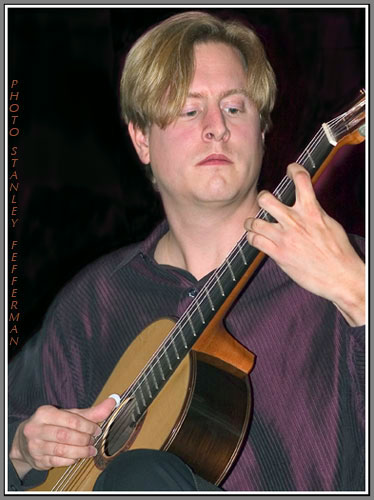 |
|
Vieaux’s repertoire included the third of five Sonatinas he has recorded on the Azica label by the Mexican composer Manuel Maria Ponce. The Sonata clasica, a 17-minute piece in four movements, revealed most of the strengths of Vieaux’s playing. Foremost is the multiple speaking voices of his guitar. The repeated notes in the bass at the start of the first movement, an Allegro in A, for example, give the impression of being voices in a conversation because of the different places on the string Vieaux’s thumb strikes during each repetition: on the sound hole, above, or below it, giving the notes a normal, mellow, or sharp ‘voice’. It becomes clear that Vieaux understands the overview of his material, knows what he wants from each note, and has the effortless technical control to express his feelings with great precision. The feelings in the Ponce composition are about energy and tenderness arrayed in the richest of colours. |
|
| Vieaux ended the first part of the program with two compositions by Isaac Albéniz (1860-1909). The “Asturias”, like many of Albéniz’s works was composed for piano but became famous as a guitar transcription. The manner in which he meets the technical demands of this piece demonstrates that Vieaux has iron in the hand that clamps string to fret without ever a buzz, while his right hand can touch the strings as lightly as a feather and allow separate notes to arise virtually out of silence. The “Torre Bermeja” with it’s very fast fingering, showed bravura and a show of affection that verged into passion.
After the intermission, Mr. Vieaux changed the tone of the recital by telling us of his love for the melodies of jazz guitarist Pat Metheny, because of their “rich harmonic backdrop”. He showed how by improvising on Metheny’s melodies he began to hear them differently. A tune like “James”, which is written with a kind of Latin rhythm, could come out like a baroque gavotte and mutate into a 6/8-gigue meter. Within a couple of weeks, Vieaux recounted, he had taken five of Metheny’s songs and arranged them as a baroque Suite with the five traditional dance-based movements. A charming story, and fascinating to follow into practice as “Last Train Home” became the allemande, “My Antonia” became the slow chaconne, and so on, but, in the execution, the first two movements sounded thin and predictable, like pop music tunes. The gavotte, with its American folk music dance meter had people tapping their feet, quietly, and following with head movements. This piece may become Vieaux’s next CD. I’d like to listen to it again before making up my mind.
It was with pleasure that we heard him turn back to Spanish based music with “Suite de Recuerdo” by the relatively unknown Argentinean composer José Luis Merlin (1951-). The piece has a lovely contemplative invocation followed by four regional dances, with the invocation repeated after the third dance. The invocation was heart rending with its plaintive call to the vanished homeland of youth, the plaintive tone continuing behind as the dramatic dance of the second movement builds through the following dances, performed with a lot of Spanish touches — rolls, slaps, knocks and dramatic chord progressions strummed at a rapid but unhurried pace, full of passion and tenderness and a streak of machismo.
The standing-room audience gave Mr. Vieaux many ovations and were rewarded with many encores. The Live Music Report received two of his CD’s, one devoted to the music of Ponce, and the other to the music of Albéniz, which it will give me great pleasure to report on in the near future.
|


